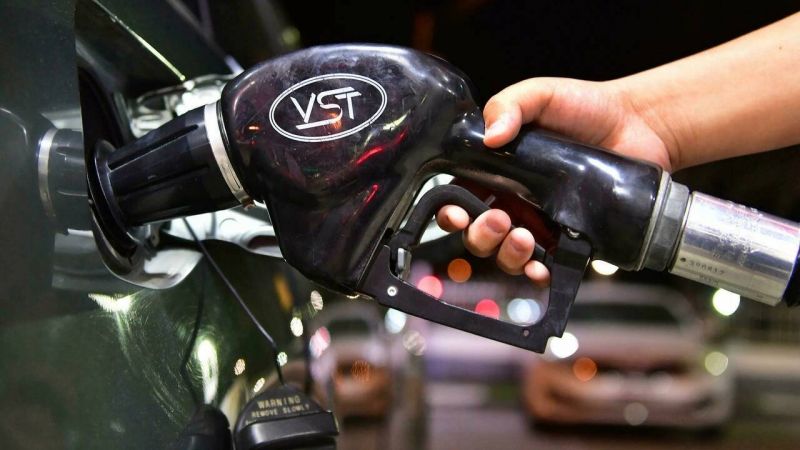
Russia's assault on Ukraine has pushed oil prices past $100 a barrel. (Credit: Frederic J. Brown/AFP)
BEIRUT — Russia’s wide-scale military campaign against Ukraine has sent global oil prices soaring past $100 a barrel to a seven-year high. Lebanon imports all of its fuel needs from overseas and has all but eliminated fuel subsidies, leaving consumers at the mercy of global fuel prices.
George Brax, spokesperson for the Syndicate of Gas Station Owners, said, “For sure we are going to see a rise in fuel prices, I’ve been talking about this since three weeks before the war erupted,” adding that “we are going to exceed LL400,000 per 20 liters for sure.”
Brax explained that fuel prices will keep increasing “at least for a month.” He also warned that if Lebanon experiences a devaluation in the lira against the dollar on the parallel market, “the prices will increase even further.”
The Lebanese lira’s sharp drop since October 2019 was arrested, at least for the time being, since mid-January following a decision by Banque du Liban to pump dollars into the foreign currency market, stabilizing its exchange rate at the parallel market around LL20,000 to the dollar.
Increased bills for gasoline and diesel, the most immediately visible consequence of an oil price surge, are only the start. The ramifications of upheaval in distant petroleum markets are poised to reverberate through a weakened state, crumbling infrastructure and poverty-stricken population trying to make ends meet.
Lebanon registered the world’s third highest inflation rate globally, behind Venezuela and Sudan, in 2021. Cost of consumer goods has already risen a staggering 239.68 percent between January 2021 and 2022. Companies in a variety of sectors have passed their own fuel costs onward to consumers, worsening inflation and increasing prices for virtually all goods in Lebanon.
“The increase of fuel prices worldwide will definitely be reflected in an increase in shipping costs and energy costs, the two main inputs of industrial costing,” said Mounir Bissat, a member of the board of directors of the Association of Lebanese Industrialists. “We expect soon an incremental effect on most of our purchases of raw and packaging materials, which will also be reflected on the price of the finished product.”
Back to the future
Bereft of its own petroleum resources, at least so far, Lebanon is dependent on fuel imports, which places the country under heavy strain when global oil prices spike. When petroleum prices hit all-time highs in the first half of 2008, the Lebanese state was confronted with a staggering energy bill, according to a Lebanese Oil and Gas Initiative report on the country’s public energy sector.
“Had those prices remained like that for another six months, or one year, we would have suffered from the same conditions we are experiencing nowadays,” Alain Tabourian — who served as energy minister at the time — told the LOGI report’s author, Noam Raydan, in reference to Lebanon’s economic crunch on the state.
Amid geopolitical upheaval, fears have risen that the price of Brent crude oil could rise as high as $150 a barrel, greater even than it’s all-time peak of $143 in July 2008. While there could be a mirroring in oil prices between 2008 and 2022, Lebanon’s public energy bill has changed dramatically since then.
Short of cash, the Lebanese state dramatically cut back spending on fuel for Electricité du Liban — which has contributed 46 percent of the country’s public debt since 1992 — in 2021. The country’s policymakers in effect pushed the costs for electricity to the businesses and residents that now need to procure the diesel needed to run inefficient and polluting backup generators to provide the power EDL no longer supplies.
Through Nov. 17, 2021, the Lebanese state allocated $525 million for EDL’s fuel consumption, with L’Orient Today estimating that more was spent this past year on diesel imports, much of it subsidized, for generators. The draft 2022 budget did not include a treasury advance for further EDL spending this year, kicking the issue off for separate cabinet discussions, and the public utility now depends on fuel provided as part of an opaque swap deal with Iraq, while hopes remain pinned for a yet-unrealized US-backed plan for the supply of Egyptian gas and Jordanian electricity.
Ripple effects
With subsidies cut, Lebanon’s diesel dependency now looms even larger as an impoverished population and cash-strapped state faces the prospect of further price increases for generator fuel.
The high cost of diesel fuel to operate generators is a significant burden on the population in additional ways, with 46 percent reporting in a recent survey that they have been forced to reduce the capacity of their generator subscription, and 22 percent suspending the subscription entirely.
Lebanon’s water and telecommunications infrastructures have been financially devastated by fuel costs. The country’s water network is perilously balanced on the edge of further interruptions, with the Beirut Mount Lebanon Water Establishment consuming up to 800,000 liters of diesel per month.
Last month, Telecommunications Minister Johnny Corm told Reuters that the fuel costs for Lebanon’s telecoms sector was expected to rise from 7 percent of its budgeted expenses to two thirds.
With many Lebanese dependent on personal cars for transportation due to lack of viable public transportation, gasoline costs are another major burden. Workers, including teachers, have complained that gasoline prices have made their commutes to work unaffordable. The same survey found that 75 percent of residents have reduced their mobility.
Developments are unfolding fast in the hours after Russia unleashed an expanded military campaign against Ukraine. The fate of global oil prices remain unclear, just as the full scale of the ramifications on small, fuel dependent Lebanon remain unknown.
The United States, at least for now, appears to be seeking to calm oil markets in the wake of a round of punishing US sanctions against Russia. An unnamed State Department official told Reuters, a day before Russia’s wide-scale military campaign, that Washington would not target Russian oil and gas flows with sanctions.
Russia produces 10 million barrels of oil per day, roughly 10 percent of global demand. Nearly a third of Europe’s oil needs and 40 percent of its gas needs are met by Russia.
“Nothing that is happening on the ground in Ukraine now, nor in coming days, is expected to affect the flow of oil to global markets,” the anonymous American official told Reuters. In the meantime, the world watches.
